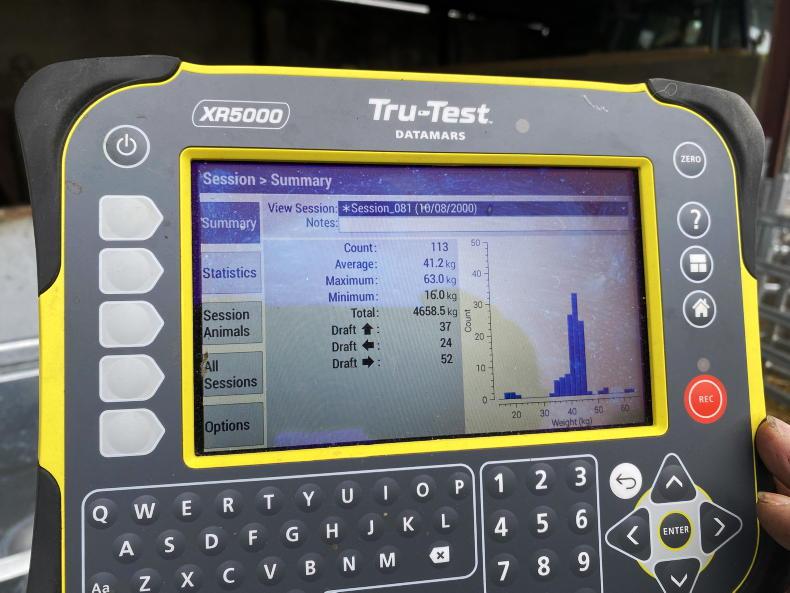Automatic sheep handling crates are a game changer for farmers looking to collect more data on their farms whilst reducing overall labour input. Today’s units are capable of weighing and drafting sheep at a rate of 800 head/hour, yet TAMS fails to decipher between high spec units and basic handlers.
The average cost for high tech units capable of automatically catching, weighing and drafting sheep (with the option of catching and holding for treatments, runs typically from €16,500 to €20,500 + VAT, with TePari and Clipex two of the main players in the game in Ireland and the UK.
The Irish designed cotter crate deserves an honourable mention as well, as similar to it’s southern hemisphere counterparts the unit can be linked up to an electronic dosing gun, with the gun calibrated to dispense dose as per the weight of the animal in the handler, effectively writing off any over or under dosing.

A sample of the information from such machines includes a head count, average, maximum and minimum weights as well as total weight of group.
As can be seen from table 1, there is no bracket in which a high-tech unit can be slotted in to and receive a fair reference cost. Even combining all three costs together equates to a reference cost of €5,698.50.
UK perspective
The UK appear to sufficiently capture these high-tech units in the Farm Equipment and Technology Fund (FETF). As opposed to the Irish TAMS, where there are two different grant rates of 40% or 60%, the FETF holds a grant rate of 50% across all items. An expected cost, similar to a reference cost in TAMS, is given, with farmers receiving 50% of this cost or the actual cost, whichever is lower. FETF72 covers automatic weighing and drafting crate for sheep, and comes with an expected average cost of item £15,992 (€ 18,596), equating to a grant amount of £7,996 (€ 9,298) per unit. In euro terms, this comes to €18,587 (€ 21,617) of an expected cost, and based off our price range of these units it will meet the actual costs of most units.
What’s needed here
In order to allow farmers to invest in labour saving technology through purchasing automatic sheep handlers, a separate category with a reasonably accurate reference cost is required. Not alone will the unit cut down on labour, but the data collected from it through 40-day weights and average liveweight gains etc. will benefit individual flocks through making better informed breeding decisions. One of the key benefits of more of these units on Irish farms would be in tackling anthelminthic resistance through targeted and accurate dosing.
Automatic sheep handling crates are a game changer for farmers looking to collect more data on their farms whilst reducing overall labour input. Today’s units are capable of weighing and drafting sheep at a rate of 800 head/hour, yet TAMS fails to decipher between high spec units and basic handlers.
The average cost for high tech units capable of automatically catching, weighing and drafting sheep (with the option of catching and holding for treatments, runs typically from €16,500 to €20,500 + VAT, with TePari and Clipex two of the main players in the game in Ireland and the UK.
The Irish designed cotter crate deserves an honourable mention as well, as similar to it’s southern hemisphere counterparts the unit can be linked up to an electronic dosing gun, with the gun calibrated to dispense dose as per the weight of the animal in the handler, effectively writing off any over or under dosing.

A sample of the information from such machines includes a head count, average, maximum and minimum weights as well as total weight of group.
As can be seen from table 1, there is no bracket in which a high-tech unit can be slotted in to and receive a fair reference cost. Even combining all three costs together equates to a reference cost of €5,698.50.
UK perspective
The UK appear to sufficiently capture these high-tech units in the Farm Equipment and Technology Fund (FETF). As opposed to the Irish TAMS, where there are two different grant rates of 40% or 60%, the FETF holds a grant rate of 50% across all items. An expected cost, similar to a reference cost in TAMS, is given, with farmers receiving 50% of this cost or the actual cost, whichever is lower. FETF72 covers automatic weighing and drafting crate for sheep, and comes with an expected average cost of item £15,992 (€ 18,596), equating to a grant amount of £7,996 (€ 9,298) per unit. In euro terms, this comes to €18,587 (€ 21,617) of an expected cost, and based off our price range of these units it will meet the actual costs of most units.
What’s needed here
In order to allow farmers to invest in labour saving technology through purchasing automatic sheep handlers, a separate category with a reasonably accurate reference cost is required. Not alone will the unit cut down on labour, but the data collected from it through 40-day weights and average liveweight gains etc. will benefit individual flocks through making better informed breeding decisions. One of the key benefits of more of these units on Irish farms would be in tackling anthelminthic resistance through targeted and accurate dosing.







 This is a subscriber-only article
This is a subscriber-only article










SHARING OPTIONS: